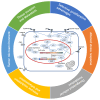Revisiting 'Hallmarks of Cancer' In Sarcomas
- PMID: 38434982
- PMCID: PMC10905407
- DOI: 10.7150/jca.92844
Revisiting 'Hallmarks of Cancer' In Sarcomas
Abstract
There is no doubt that anyone who has participated in cancer care or research has once read the 'Hallmarks of Cancer' papers published by Hanahan and Weinberg in 2001 and 2011. They initially defined the six qualities of cancer cells as cancer hallmarks in 2001, but expanded that to 11 as a next generation in 2011. In their papers, they discussed the potential treatment strategies against cancer corresponding to each of the 11 hallmarks, and to date, proposed therapies that target genes and signaling pathways associated with each of these hallmarks have guided a trail that cancer treatments should take, some of which are now used as standard in clinical practice and some of which have yet to progress that far. Along with the recent advances in cancer research such as genomic analysis with next generation sequencing, they can be reconverged to an alternative six categories defined as selective proliferative advantages, altered stress response, deregulated cellular metabolism, immune modulation and inflammation, tumor microenvironment, tissue invasion and metastasis. In this paper, we will overview the current state of these alternative hallmarks and their corresponding treatments in the current sarcoma practice, then discuss the future direction of sarcoma treatment.
Keywords: cancer biology; hallmarks of cancer; precision medicine; sarcoma.
© The author(s).
Conflict of interest statement
Competing Interests: The authors have declared that no competing interest exists.
Figures









References
-
- Hanahan D, Weinberg RA. The hallmarks of cancer. Cell. 2000;100:57–70. - PubMed
-
- Hanahan D, Weinberg RA. Hallmarks of cancer: the next generation. Cell. 2011;144:646–74. - PubMed
-
- Hanahan D. Rethinking the war on cancer. Lancet. 2014;383:558–63. - PubMed
-
- Boddu S, Walko CM, Bienasz S, Bui MM, Henderson-Jackson E. et al. Clinical Utility of Genomic Profiling in the Treatment of Advanced Sarcomas: A Single-Center Experience. JCO Precision Oncology. 2018;2:1–8. - PubMed
Publication types
LinkOut - more resources
Full Text Sources

